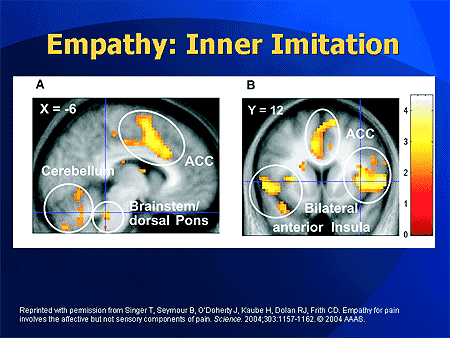
Hmmmm . . . interesting, and a little scary. If we can pinpoint it in the brain, someone is going to make a pill to increase it or create a way to remove it from soldiers. By the way, one of the supervising (I think) researchers on this study was Hanna Damasio, a frequent research partner of Antonio Damasio (the couple that works together stays together?).
[Image is from a different study.]
Source of Empathy in the Brain?
ScienceDaily (July 17, 2011) — Your brain works hard to help understand your fellow person -- no matter how different they may be. According to a new study from USC, even failing to possess a full complement of limbs will not stop your brain from understanding what it is like for someone else to experience pain in one of them. It may, however, change the way your brain does so.
In a paper published online by Cerebral Cortex, USC researcher Lisa Aziz-Zadeh furthered her ongoing work in mapping out the way the brain generates empathy, even for those who differ physically from themselves.
According to Aziz-Zadeh's findings, empathy for someone to whom you can directly relate -- or example, because they are experiencing pain in a limb that you possess -- is mostly generated by the intuitive, sensory-motor parts of the brain. However, empathy for someone to whom you cannot directly relate relies more on the rationalizing part of the brain.
Though they are engaged to differing degrees depending on the circumstance, it appears that both the intuitive and rationalizing parts of the brain work in tandem to create the sensation of empathy, said Aziz-Zadeh, assistant professor at USC's Division of Occupational Science and Occupational Therapy.
"People do it automatically," she said.
In an experiment, Aziz-Zadeh and a team from USC showed videos of tasks being performed by hands, feet, and a mouth to a woman who had been born without arms or legs and also to a group of 13 typically developed women. Videos showed activities such as a mouth eating and a hand grasping an object.
Researchers also showed videos of pain, in the form of an injection, being inflicted on parts of the body.
While the participants watched the videos, their brains were scanned using functional magnetic imaging (fMRI), and then those scans were compared, revealing the differing sources of empathy.
In an additional finding, Aziz-Zadeh discovered that when the congenital amputee viewed videos of tasks being performed that she could also perform but using body parts that she did not have, the sensory-motor parts of her brain were still strongly engaged. For example, the participant can hold objects, but uses a stump in conjunction with her chin to do so rather than a hand.
If the goal of the action was impossible for her, then another set of brain regions involved in deductive reasoning were also activated.
Aziz-Zadeh's research was funded by The Brain and Creativity Institute; The Division of Occupational Science and Occupational Therapy at USC; National Science Foundation Graduate Research Fellowship; USC Provost's PhD Fellowship.
Journal Reference:
L. Aziz-Zadeh, T. Sheng, S.-L. Liew, H. Damasio. Understanding Otherness: The Neural Bases of Action Comprehension and Pain Empathy in a Congenital Amputee. Cerebral Cortex, 2011; DOI: 10.1093/cercor/bhr139
Tags:
No comments:
Post a Comment